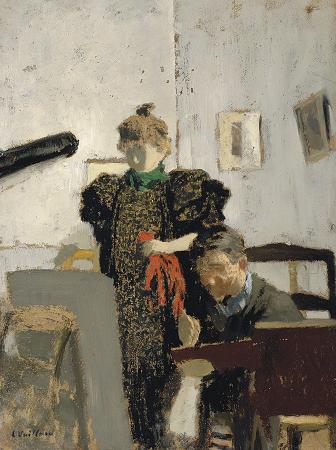Edouard Vuillard (1868 - 1940). Jean-Édouard Vuillard was a French painter, decorative artist and printmaker. From 1891 through 1900, he was a prominent member of the Nabis, making paintings which assembled areas of pure color, and interior scenes, influenced by Japanese prints, where the subjects were blended into colors and patterns. He also was a decorative artist, painting theater sets, panels for interior decoration, and designing plates and stained glass. After 1900, when the Nabis broke up, he adopted a more realistic style, painting landscapes and interiors with lavish detail and vivid colors. In the 1920s and 1930s he painted portraits of prominent figures in French industry and the arts in their familiar settings. Jean-Édouard Vuillard was born on 11 November 1868 in Cuiseaux, where he spent his youth. Vuillard's father was a retired captain of the naval infantry, who after leaving the military became a tax collector. His father was 27 years older than his mother, Marie Vuillard, who was a seamstress. In 1877, after his father's retirement, the family settled in Paris at 18 rue de Chabrol, then moved to Rue Daunou, in a building where his mother had a sewing workshop. Vuillard entered a school run by the Marist Brothers. He was awarded a scholarship to attend the prestigious Lycée Fontaine, which in 1883 became the Lycée Condorcet. Vuillard studied rhetoric and art, making drawings of works by Michelangelo and classical sculptures. At the Lycée he met several of the future Nabis, including Ker-Xavier Roussel, Maurice Denis, writer Pierre Véber, and the future actor and theater director Aurélien Lugné-Poe. In November 1885, when he left the Lycée, he gave up his original idea of following his father in a military career, and set out to become an artist. He joined Roussel at the studio of painter Diogène Maillart, in the former studio of Eugène Delacroix on Place Fürstenberg. There, Roussel and Vuillard learned the rudiments of painting. In 1885 he took courses at the Académie Julian, and frequented the studios of the prominent and fashionable painters William-Adolphe Bouguereau and Robert-Fleury. However, he failed in the competitions to enter the École des Beaux-Arts in February and July 1886 and again in February 1887. In July 1887, the persistent Vuillard was accepted, and was placed in the course of Robert-Fleury, then in 1888 with the academic history painter Jean-Léon Gérôme. In 1888 and 1889, he pursued his studies in academic art. He painted a self-portrait with his friend Waroquoy, and had a crayon portrait of his grandmother accepted for the Salon of 1889. At the end of that academic year, and after a brief period of military service, he set out to become an artist. Late in 1889 he began to frequent the meetings the informal group of artists known as Les Nabis, or The prophets, a semi-secret, semi-mystical club which included Maurice Denis and some of his other friends from the Lycée. In 1888 the young painter Paul Serusier had traveled to Brittany, where, under the direction of Paul Gauguin, he had made a nearly abstract painting of the seaport, composed of areas of color. This became The talisman, the first Nabi painting. Serusier and his friend Pierre Bonnard, Maurice Denis and Paul Ranson, were among the first Nabis of nabiim, dedicated to transforming art down to its foundations. In 1890, through Denis, Vuillard became a member of the group, which met in Ransom's studio or in the cafes of the Passage Brady. The existence of the organization was in theory secret, and members used coded nicknames; Vuillard became the Nabi Zouave, because of his military service. He first began working on theater decoration. He shared a studio at 28 Rue Pigalle with Bonnard with the theater impresario Lugné-Poe, and the theater critic Georges Rousel. He designed sets for several works by Maeterlinck and other symbolist writers. In 1891 he took part in his first exposition with the Nabis at the Chateau of Saint-Germain-en-Laye. He showed two paintings, including The Woman in a Striped Dress. The reviews were largely good, but the critic of Le Chat Noir wrote of Works still indecisive, where one finds the features in style, literary shadows, sometimes a tender harmony. Vuillard began keeping a journal during this time, which records the formation of his artistic philosophy. We perceive nature through the senses which give us images of forms, sounds, colors, etc. he wrote on 22 November 1888, shortly before he became a Nabi. A form or a color exists only in relation to another. Form does not exist on its own. We can only conceive of the relations.
more...














